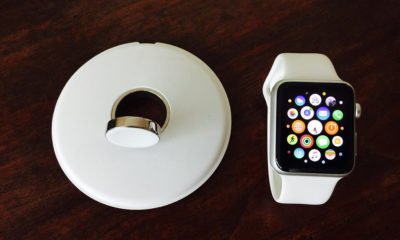Biotech
World’s Smallest Dissolvable Pacemaker Offers Breakthrough for Newborn Heart Care
Northwestern University researchers have created the world’s smallest, dissolvable pacemaker for critically ill newborns. Injected via syringe and activated by a chest patch using infrared light, it regulates heart rhythm during recovery from congenital heart surgery. Made from biocompatible materials, it dissolves naturally, eliminating removal risks. Its tiny size enables precise, synchronized, multisite heart pacing.

Researchers at Northwestern University in Illinois, USA, have developed the world’s smallest pacemaker, a dissolvable device designed to stabilize the heart rhythm of critically ill newborns. Smaller than a grain of rice, it can be injected with a syringe and activated by a flexible patch placed on the chest that detects irregular heartbeats and emits light to trigger electrical pulses.
It is specifically designed for infants recovering from surgery for congenital heart defects , stabilizing heart rhythms during the critical one-week recovery period and dissolving naturally after use, eliminating the need for surgical removal. When this wearable device detects an irregular heartbeat, it automatically emits a pulse of light that passes through the skin, breastbone, and muscles to activate the pacemaker and regulate the heart’s rhythm.
Initially designed for patients requiring temporary pacing , especially newborns with congenital heart defects, the pacemaker is made of biocompatible materials that dissolve naturally into the body’s biofluids once no longer needed, eliminating the need for surgical removal.
The tiny pacemaker measures just 1.8 millimeters wide, 3.5 millimeters long, and 1 millimeter thick
According to researchers, after heart surgery, it’s common for patients to require temporary pacemakers to stabilize their heart rhythm during recovery or while waiting for a permanent device to be implanted. Traditionally, surgeons suture electrodes to the heart muscle, with wires extending outside the chest and connecting to an external pacemaker that regulates heart rate.
However, this approach can lead to complications , including infection, hematomas, cardiac tamponade, and even death in some cases. Furthermore, removing the electrodes can cause tissue tears or damage, bleeding, and blood clots.
In response to the need for safer and more efficient temporary pacemakers, they developed a bioresorbable pacemaker in 2021. This thin, flexible, and lightweight device eliminates the need for bulky batteries and rigid hardware, including wires, thereby reducing the risks of infection and tissue damage associated with traditional pacemakers.
This lab had previously introduced the concept of bioresorbable e-medicine : electronic devices that provide therapeutic benefits and then dissolve harmlessly in the body, similar to absorbable sutures. By adjusting the composition and thickness of these devices’ materials, Rogers’ team can precisely control how long they remain functional before dissolving, tailoring them to each patient’s specific needs.
Now, this tiny pacemaker measures just 1.8 millimeters wide, 3.5 millimeters long, and 1 millimeter thick. It connects to a portable, soft, flexible, wireless patch placed on the patient’s chest to monitor cardiac pacing. When this patch detects an irregular heartbeat, it automatically emits a pulse of infrared light that passes through the skin, sternum, and muscles to activate the pacemaker and regulate the heart’s rhythm.
Infrared light penetrates the body effectively, allowing the device to operate efficiently despite its small size.
Thanks to its small size, multiple devices can be implanted in different areas of the heart, allowing for more precise and synchronized pacing. Each pacemaker can be activated independently using different wavelengths of light, facilitating specific control of each device.
This multisite and multimodal pacing capability offers more sophisticated synchronization compared to traditional pacing and could be particularly useful in the treatment of arrhythmias by allowing stimulation of different regions of the heart at varying rates.
__
(Featured image by Carlos Martinez via Unsplash)
DISCLAIMER: This article was written by a third party contributor and does not reflect the opinion of Born2Invest, its management, staff or its associates. Please review our disclaimer for more information.
This article may include forward-looking statements. These forward-looking statements generally are identified by the words “believe,” “project,” “estimate,” “become,” “plan,” “will,” and similar expressions. These forward-looking statements involve known and unknown risks as well as uncertainties, including those discussed in the following cautionary statements and elsewhere in this article and on this site. Although the Company may believe that its expectations are based on reasonable assumptions, the actual results that the Company may achieve may differ materially from any forward-looking statements, which reflect the opinions of the management of the Company only as of the date hereof. Additionally, please make sure to read these important disclosures.
First published in GACETA MEDICA. A third-party contributor translated and adapted the article from the original. In case of discrepancy, the original will prevail.
Although we made reasonable efforts to provide accurate translations, some parts may be incorrect. Born2Invest assumes no responsibility for errors, omissions or ambiguities in the translations provided on this website. Any person or entity relying on translated content does so at their own risk. Born2Invest is not responsible for losses caused by such reliance on the accuracy or reliability of translated information. If you wish to report an error or inaccuracy in the translation, we encourage you to contact us

-

 Markets5 days ago
Markets5 days agoMixed Market Trends as Global Coffee Growing Conditions Improve
-

 Africa2 weeks ago
Africa2 weeks agoForeign Investor Activity in Morocco’s Equity Market in 2024
-

 Fintech3 days ago
Fintech3 days agoPayPal Under Fire: Excessive Data Collection and Privacy Concerns in Advertising
-

 Biotech1 week ago
Biotech1 week agoJohnson & Johnson’s Tecvayli Combo Shows Breakthrough Results in Multiple Myeloma















